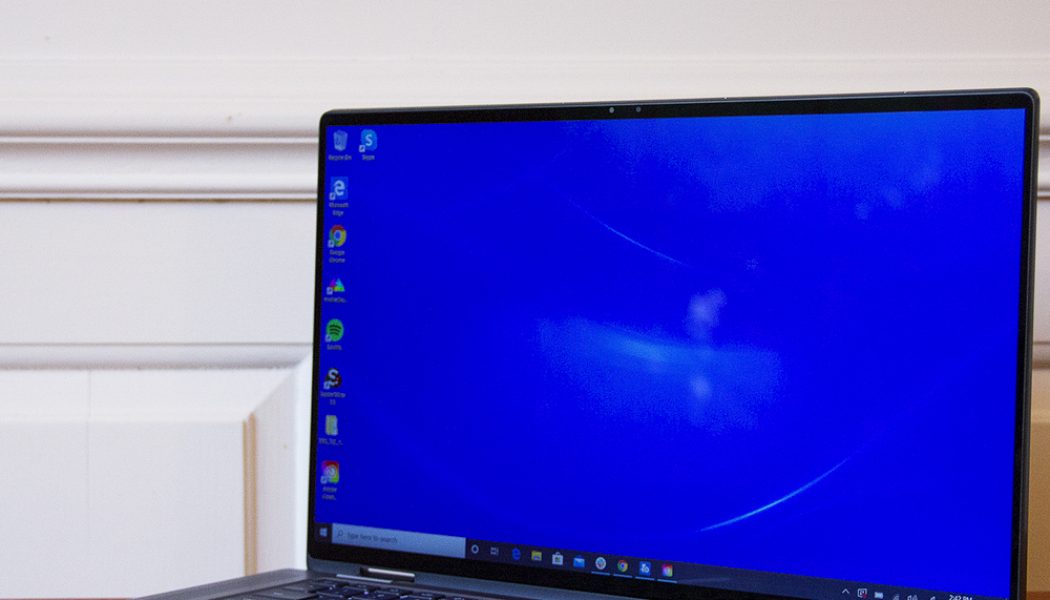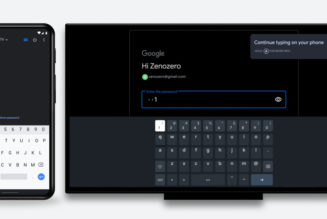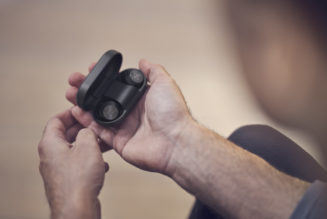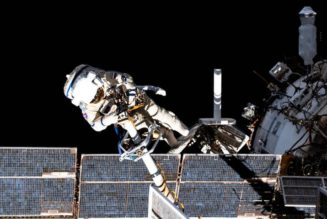This laptop was a pain in the neck to review. That’s because the battery life is so gargantuan that our traditional rundown test was next to useless. I’ve praised the battery life of several thin-and-light systems this year — Lenovo’s IdeaPad Slim 7 is a monster. But nothing — and I mean nothing — that I have ever used comes close to topping the lifespan this device has.
This is the Dell Latitude 9510 2-in-1. As is often the case with premium, convertible business laptops, there are about a million different configurations with a variety of processors and other specs. The base model, currently listed at $1,848.99, comes with a quad-core Core i5-10210U, 128GB of storage, and 8GB of RAM; our test model, currently listed at $1,848.99, comes with a six-core Core i7-10810U, 16GB of RAM, and a 512GB SSD. It has the same Intel UHD integrated graphics and 15.6-inch 1920 x 1080 touch display that’s available across the line.
Right away, $3,000 seems like a lot to ask for those specs. It also makes the Latitude an unrealistic option for many consumers. Business laptops tend to run more expensive than popular consumer laptops, and they often include a number of advanced security and remote management features to justify the price. (Plus, companies that buy these things in bulk aren’t usually paying sticker price.) Unfortunately, this laptop costs more than most of those without offering drastically better benefits for most people — so I’m only comfortable recommending it to a very specific swath of business users. That said, it’s a remarkable piece of technology.
Starting with the outside: I’m a huge fan of the peripherals on this thing. The keyboard is one of my favorites that I’ve used all year. It’s hard to explain why, since I actually clocked in below my average typing speeds — the keys are just really smooth and comfortable, with excellent travel and an absurdly satisfying click. I did hear the occasional squeak from the spacebar and backspace keys.
The 4.5 x 2.6-inch touchpad is also great, with a really nice, smooth glass and an effortless click. Windows Precision gestures worked as advertised. For other inputs, the 9510 has a very serviceable port selection including an HDMI 2.0, two USB-C Thunderbolt 3 ports, a microSD slot, and an optional SmartCard reader on the left, as well as one USB-A, one headphone jack, and one wedge lock on the right side.
:no_upscale()/cdn.vox-cdn.com/uploads/chorus_asset/file/21967137/mchin_190102_4234_0002.0.jpg)
The 9510 won’t be winning any beauty pageants, but it’s sturdy and feels exceptionally well made in the way I’ve come to expect from Dell. The chassis is aluminum with a professional silver finish. There’s no flex anywhere. I would put this in a suitcase, briefcase, or backpack — I could use it on the bus or bring it on a hike. And there’s also no wobble in the hinge when the laptop is in tablet or tent mode, which is sometimes an issue with thin-and-light convertibles.
On the flip side: At 3.7 pounds, I do find this laptop a bit too heavy to use as a tablet. It’s just a lot to hold steady with one hand while navigating with the other. I was often wobbly, and got tired pretty quickly. Despite how hefty it feels, though, it’s on the small side for a 15-inch laptop — Dell claims it’s the world’s smallest 15-inch business PC.
The 13.4 x 8.4 x 0.55 inch chassis has a smaller footprint than the company’s other 15-inchers like the XPS 15 (13.57 x 9.06 x 0.71) and the Precision 5550 (13.56 x 9.07 x 0.30). It’s decently thin as well — even thinner than some 14-inchers for which portability is a major selling point, like Dell’s Latitude 9410 (0.49 inches) and HP’s Spectre x360 14 (0.67 inches).
:no_upscale()/cdn.vox-cdn.com/uploads/chorus_asset/file/21967134/mchin_190102_4234_0005.0.jpg)
Portability is really the goal of this Latitude, because there’s no way you’re buying this if you don’t plan to take advantage of its absurd battery life. This thing lasted me an average of 14 hours and 40 minutes. That was with an office workload (around a dozen Chrome tabs and Slack), a couple Zoom calls, and some Spotify and YouTube streaming, with the screen at 200 nits of brightness, the Quiet thermal profile selected, and Dell’s Battery Extender on. (Battery Extender lower’s the CPU’s power, but it didn’t impair performance in my real-world use).
Note that this was with continuous use; I didn’t let the laptop go to sleep or dim the screen. If you’re giving this thing breaks, you’ll probably make it two days without needing to touch a charger.
:no_upscale()/cdn.vox-cdn.com/uploads/chorus_asset/file/21967136/mchin_190102_4234_0003.0.jpg)
To put that in context: Generally with this workload, which is very consistent between tests, I get seven to nine hours out of good Windows laptops that aren’t running a GPU. I got 11 and a half hours out of HP’s Elite Dragonfly, the gold standard for premium business laptops. The only other laptop I’ve tried this year that’s come close to this result is Lenovo’s IdeaPad Slim 7 — and the Latitude beats that by a good hour.
Another unusual point of praise: The audio was good. The Latitude takes advantage of what Dell calls a “smart amp” to improve bass and reduce distortion, as well as tuning from Waves Maxx Audio software. I could actually hear the bass in music (a rarity) and percussion was particularly strong.
The microphones (there are four) are also quite good, and picked up my answers perfectly in voice-recognition tasks where other laptops sometimes have trouble. The webcam, though, is bad — people in my Zoom meetings commented on how dark and grainy I looked.
Inside, the Latitude has a new cooling system that includes two heat pipes, carbon fan blades, and an insulating gel that Dell says was also used in Nasa’s Stardust probe. These claims are sometimes marketing gobbledygook, but I never felt much heat here (even in parts you’d expect to get toasty, like the area around the hinge).
This laptop doesn’t have the latest processors from Intel (business laptops probably won’t be getting those until next year, when vPro SKUs are released) but the six-core 10th-Gen i7 works great. It handled my workload without any slowdown or fan noise. It does have integrated graphics (Intel’s UHD), which means it’s not a good choice for gaming or creative work, though.
The Latitude took 28 minutes to export a five-minute, 33-second video in Adobe Premiere Pro. That’s slower than last year’s XPS 13 with a Core i7-10710U (and UHD graphics), which took 24 minutes to complete the same task. It’s also, of course, much slower than 11th-Gen systems equipped with Intel’s latest integrated graphics like the Asus Zenbook Flip S, which finished the task in just over 11 minutes. Again, not an unexpected result, but at this price point it would be nice to see some sort of discrete graphics option for folks who need to work with media from time to time.
Finally, the Latitude comes with a number of customization options via its Dell Optimizer software. There’s ExpressResponse, where you can select your most frequently used applications for the Latitude to “optimize” for better performance based on your usage patterns. With Intelligent Audio, you can toggle video-call features like noise cancellation and volume with presets based on your setting: “Quiet Room”, “Noisy Office” etc. There’s ExpressCharge, which is said to speed up charging and extend battery life based on your usage, but I couldn’t test this because it takes two weeks to learn your behavior.
The feature I find most useful is called Proximity Sensor — it automatically locks the laptop when you’re away from it, and wakes it back up when you return. If you set up Windows Hello face recognition, it can instantly sign you back in as well. This worked very well during my testing period. It doesn’t do much for privacy when the laptop is in use, however, which can be important for business users. At this price point, I’d hope to see something like HP’s SureView Reflect (which tints the screen such that you can’t snoop over someone’s shoulder) or the software on Lenovo’s IdeaPad Slim 7 that blurs the display when you’re looking away.
:no_upscale()/cdn.vox-cdn.com/uploads/chorus_asset/file/21967135/mchin_190102_4234_0004.0.jpg)
Speaking of the screen, that’s really the one part of this laptop that I found disappointing. The Latitude borrows the InfinityEdge borders that Dell has been touting on its XPS models, and while the top and bottom rims are more visible than they are on the XPS 15, the display still looks quite wide. But it only reaches 332 nits of brightness — that’s bright enough for most people, sure, but we’d hope to see more from a business flagship. Today’s Dragonflys, Thinkpads, Expertbooks, and Elitebooks offer 1000-nit options. The Latitude is also 16:9 with 1920 x 1080 resolution; I’m surprised not to see a 4K option at this price, and the 16:9 aspect ratio can be cramped when it comes to multitasking in multiple windows.
Overall, the battery life is the star of the show. The Latitude is top of its class there, and the solid build quality, AI features, and stellar keyboard and touchpad are nice to have as well. There are some customers for whom this laptop might make sense: People for whom the 17-hour battery life is a must-have at all costs, and companies who have need for Dell’s specific security features and enterprise ecosystem.
:no_upscale()/cdn.vox-cdn.com/uploads/chorus_asset/file/21967133/mchin_190102_4234_0006.0.jpg)
For consumers and small-business customers, the Latitude might be a great buy at a discount. But without a 4K screen, discrete graphics, or a standout screen, it’s not worth sticker price. Anyone who doesn’t need those components should be just fine with the Elite Dragonfly or Asus’s ExpertBook B9540, both of which are comparable to the Latitude in most areas (and better in some) while also being $1,000 cheaper.
Photography by Monica Chin / The Verge










